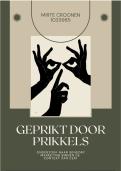,2
, Voorwoord
In het kader van CEM kreeg ik de opdracht om een individueel beroepsproduct te maken,
bestaande uit drie onderdelen: een onderzoek, blog en Engelse samenvatting. Elke student mocht
zelf een onderwerp uitkiezen en ik koos voor sensory marketing.
Ik ben er gedurende het eerste schooljaar achter gekomen dat vooral de psychologische kant van
marketing me aanspreekt. Hoe worden we beïnvloedt en in hoeverre hebben we dat zelf door? Dit
waren vragen die door mijn hoofd gingen en die ik graag beantwoord wilde hebben. Heb ik nu
antwoorden op al mijn vragen? Nee, zeker niet. Het is een breed onderwerp dat tot verkort niet zo
heel erg in de media aanwezig was. We weten vrij wel allemaal dat onze zintuigen geprikkeld
worden tijdens onze klantenreis, maar we worden vaker beïnvloedt en zelfs gemanipuleerd dan we
door hebben. Na mijn onderzoek zijn bepaalde vermoedens bevestigd, maar heb ik ook nieuwe
dingen geleerd. Ik vond het zeer interessant om me hier in te verdiepen en ik hoop dat de lezers van
mijn blog dat ook zo zullen ervaren. Ik hoop dat mensen iets leren van mijn blog en de informatie
willen doorvertellen aan vrienden en familie. Ik heb dat namelijk ook gedaan.
Naast het blog en onderzoek heb ik ook een Engelse samenvatting gemaakt. Een A4’tje met de
belangrijkste punten bij elkaar. Een bondig stukje dat de belangrijkste bevindingen bevat. Het blog
en de samenvatting lijken inhoudelijk een beetje op elkaar, maar verschillende sterk in vorm,
spreekstijl en uiteraard in taal.
Bij deze wil ik graag gebruik maken om Ingrid Faassen, Kristel Klaassen en Leyla Ocel te
bedanken voor de begeleiding.
Rotterdam, januari 2023
Mirte Croonen
3
, Executive summary
Sensory marketing stimulates the senses during the customer journey. Research has been done on
the meaning of sensory marketing, brand relevance, brand examples, consumer experience, and
optimizing and maintaining the customer experience. The information and outcomes of this in-
depth research are derived from existing studies and a survey conducted for this study.
The meaning and effect of sensory marketing
Sensory marketing is a form of marketing in which smell, taste, touch, visual and sound stimuli are
used. It is a form of branding that does not stand by itself. Sensory marketing is all about the
organism (the consumer) and how it responds to the stimuli coming in through the senses,
according to Ivar Vermeulen (Swocc, 2021). A literature study by Rockefeller University shows
that consumers remember 1% of what they feel, 2% is due to hearing, 5% to seeing, 15% to tasting,
and 35% to smelling. Looking at the results of the survey (conducted for this research) and
previous studies, it appears the effects of smell and sound have the most positive effects on
consumer moods. By stimulating the senses, a brand can firmly anchor itself into the consumers’
brain. The more sensory experiences, the more loyal the customer is to the brand. According to a
global study by Moore (2019), it appears that 85% to 95% of all purchases made consist of
subconscious decisions triggered by sensory marketing. Consumers are often aware of the triggers,
but in practice, they are manipulated more often and faster than they realize.
Well-known brands that stimulate the senses
In practice, sensory marketing is regularly used by brands. An example of an effective marketing
campaign is Dunkin’ Donuts “flavor radio”. This campaign anticipated strongly to smell and sound
by playing a Dunkin' Donuts jingle and spreading coffee aroma on public transport at the same
time. The results: 16% more visitors to the shops around public transport and 29% more in sales
(Marinkovic, 2020). The campaign has proven that a sensory strategy can be built around two
senses. However, a campaign is most effective when all senses are stimulated, according to Moore
(2019).
Another example of a well-known brand is Coca-Cola. The red, characteristic packaging ensures
the taste. If the focus is solely on taste, Pepsi will be preferred to Coca-Cola according to the
experiment “Pepsi Challenge”. This is due to the association one has with a color according to
Vleuten (2022). For example, blue stands for reliability, and red for passion. A brighter packaging
is more likely to taste better, whereas less colorful packaging will be interpreted as healthier.
Stimulate the consumer's senses
When using sensory marketing, it is important to look at the brand outcomes that want to be
achieved, which senses are suitable and what is feasible. The content of the stimulus must not have
any negative side effects regarding the emotion or behavior of the consumer. A simple form that
already contributes to a better customer experience is sending a gift with the package.
Technological developments such as a smelling screen or a digital try-on can also be used. The
target group must be considered. A digital try-on for example is more suitable for the younger
target group.
Use sensory marketing and increase sales
Within CEM, a brand can respond to sensory marketing in various areas. It is important that the
brand personality is put first and sensory overload is avoided. Every consumer experience incentive
differently, but when used correctly it will have a positive effect on sales. If all senses are
stimulated, consumers will spend six minutes longer in the store to absorb the products according
to Moore (2019). Resulting in more expensive products in the shopping cart. In conclusion: use
sensory marketing to increase sales, to become memorable and unique, and to embed into the mind
of the consumer.
4





